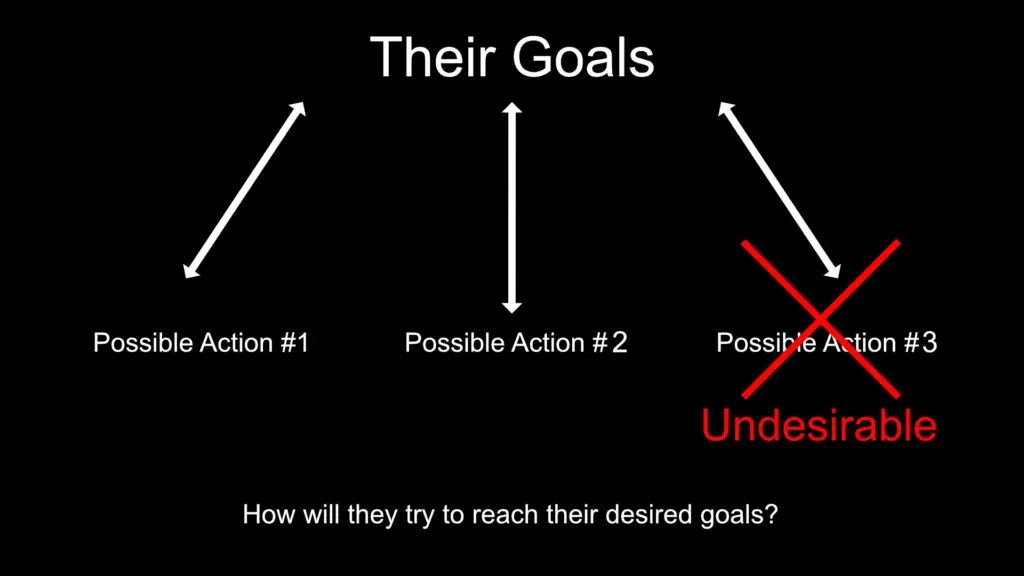The popular character Tommy Shelby is a strategic genius. How does he do it? Here’s a clue.
Tommy Shelby is a strategic genius because he has an intuitive sense for something we now call Game Theory. Game Theory is the study of strategic situations. It seeks to provide people the best possible strategies in a given situation. If you like Sun Tzu, 33 Strategies of war, or military strategy, you might like game theory.
Here is the first way you can become more strategic with Game Theory.
Table of Contents
Strategic Tool 1/3: Seek Dominant Strategies
To win strategic situations, take time to seek dominant strategies. A dominant strategy is one where you win in no matter what the other person does.
When Tommy invited Grace to meet, he knew she had another life. He wasn’t sure exactly what was going to come out of this meeting, and he knew it would rely heavily on what she chose to do. She could either choose to start up a relationship with him again, or she could choose to walk away. Instead of being reactive and letting her hold control the situation, he deploys a seemingly simple statement.

“I changed my mind. I think I made a mistake bringing you here tonight. You should probably leave.”
This boxes her into a corner, leaving her with two options.
- Grace can walk away and prove Tommy correct. This is a win because he forces her to make an almost immediate decision. He’ll learn her answer up front, with out wasting time desperately trying to read or change her mind. He is in control and doesn’t really loose much because he predicted the result. His statement protects him against a much worse negative.
- She can stay and try to “prove” her interest to Tommy. Then he really wins.
Ask this
Find dominant strategies by simply asking yourself this question. “How can I position myself so I win no matter what my opponent does?”
You can also use the second strategic Game Theory technique.
Strategic Tool 2/3: Use Backwards Induction
Learn to use Backwards Induction. Backwards induction is when you start with the results of a situation, and then reason backwards to find the best strategy. Backwards induction can lead you to spotting dominant strategies. But did Tommy really use backwards induction?
We think so. At very least, we know Tommy strategized about this situation long before it happened.
“What I really planned on doing is taking you to see Charlie Chapman.”
Before the meeting, Tommy was aware that there was a party happening with Charlie Chapman. We also know the meeting was planned, in part because of how calculated what he says to the constable is.
“I am going to bring the girl you liked back to my home to make you angry.”
Diagramming
So how can you get under your opponent’s skins?

Learn to use backwards induction by diagramming out the following steps. First choose a critical situation coming up in your life. Write out what your opponent wants and the actions they might take to get it. Locate the actions and results you don’t want them to take. Then ask yourself what you can do or say to make sure they don’t do something that leads to that result.
Backwards induction leads us to dominant strategies because it focuses us on results. If we are aware of the results we don’t want, and actions that might lead to those results, we can more easily prevent those things from happening. If we prevent those bad outcomes from happening, we’ve placed our self into a dominant position.
But once we know the paths we don’t want to go down, how do we box someone in to the paths we do want?
Strategic Tool 3: Box them In
This clip holds the answer. A fund manager wants to hire a performance psychologist who is feuding with her old boss. But trying to hire someone puts you into a vulnerable position, since they can always just turn you down. The manager wants to eliminate this path.
“Tell me what you know about Bobby from your private therapy sessions.”
First we should note that this conversation is probably mostly about impressing Wendy with his strategic abilities, more than anything else. That just happens to involve using Game Theory. And it seems to work.
“He played some heavy game theory where he won no matter what I did.”
If she tells him about his competitor’s weaknesses, he wins and gets valuable information. He also gets leverage on her because she breaks confidentiality. If she refuses, he can pretend it was a test and that she passed. He can still try to hire her. Either way he is in a dominant position.
Statements or Questions
You can box people in by either making statements, like Tommy, or asking questions, like Krakow.
For the statement method, simply make some version of an “I don’t think this is a good idea anymore,” claim. These are best employed when the other side has invested something in the meeting, like traveling a long distance or spending time to create a presentation. The statement method works best when you have more power or options, and you want to test the interest level of the other person before you commit. It can add to your leverage by making already interested parties clamor for your time.
For the question method, simply ask mildly invasive questions. Sales people do this all the time, though most don’t really understand what they are doing. They will ask questions like “how long have you been having delivery truck issues?” If the prospect answers, the sales person has valuable information they can use to hold firm in negotiations. Why would they lower the price if they know the prospect is losing tons of money from this problem? If the prospect doesn’t answer, the sales person simply learns this person doesn’t have a large enough pain point. They need to move along and find someone else.
